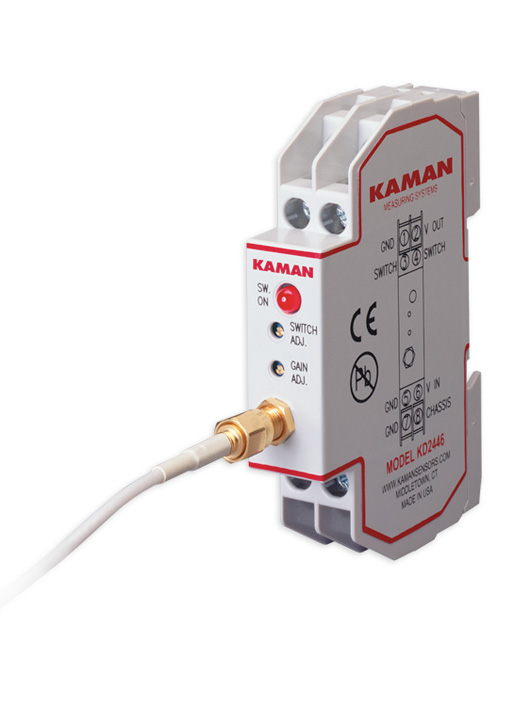New non-contact proximity measuring sensor

Kaman Precision Products offers a new, non-contact proximity sensing solution for wide ranging power electronics applications. Its built-in switch output control provides easier set-up and calibration while also delivering speed and precision in a new compact form factor. By: Kevin Conlin, Kaman Precision Products
Manufacturing and design industries require increasing precision of measurement. Selecting the right non-contact proximity measuring system can be essential to a successful project that stays on time and on budget. Using a measuring system that is non-contact and employs eddy current sensing technology allows for high-accuracy proximity measurement even in rugged surroundings. The design of this non-contact measurement system includes switched output, which results in fewer parts to order, assemble and calibrate. These advantages will shorten design, testing and development timelines. Factors such as accuracy, cost and set-up time become more important as the speed of business continues to increase.
Non-contact measuring devices with eddy current sensing are well-suited to a diverse array of applications. Many instruments are available in the technical sensor market to measure position, distance, or vibration of an object. These can be placed into two basic categories: contact and non-contact. While contact instruments are suitable for many applications, they have a limited frequency response and can interfere with the dynamics of the object being measured. Where these factors are a concern, non-contact methods offer advantages such as higher precision and less interference.
As with any device, both contact and non-contact measuring technologies have a wide range of performance characteristics ranging from very low (on-off) to very high precision (nanometer resolution), depending on their construction. It is not only necessary to choose the correct technology, one should also make selections based upon the correct level of performance an application requires.
Selecting the right technology for a non-contact proximity measurement will come down to environment and performance requirements. There are three primary technologies used in developing non-contact proximity sensor systems: capacitance displacement, laser displacement, and eddy current detection. Kaman Precision Products (Kaman) uses eddy current sensor technology because of its broad, flexible application in multiple industry settings.
Eddy current sensors are well suited for all environments ranging from inside internal combustion engines to semiconductor clean rooms; and unlike capacitance sensors, they are not influenced by anything that comes between the sensor face and the target. Eddy current sensors also have advantages over laser sensors in higher-temperature environments since eddy current devices can typically withstand higher ambient temperatures than laser sensors that have their electronics integral with the sensing head. Kaman's KD-2446 non-contact high-precision measuring system operates on the principle of impedance variation caused by eddy currents induced in a conductive target by a sensor coil. This technology is capable of sub-micro inch resolution.
The KD-2446 may be used in a variety of applications that involve target materials such as ferrous steel, stainless steel or aluminum. Applications include displacement, vibration, sorting and event capture sensing requirements. Its excellent sensitivity to small targets and high-speed switching also makes it ideal for RPM sensing in harsh environments.
In addition to its high precision measuring capabilities to 12 micro inches, the KD-2446 also offers opto-isolated switched output for process control, making it ideal for interfacing to PLC inputs, counters, timers or alarm circuits. The switch is integrated directly within its housing, eliminating the need to purchase additional equipment or wire into other components. This makes measuring simple and more rapidly executed.
Beyond its simple construction, integrated features and low price-point, other key benefits of the KD-2446 include:
"¢ Variable voltage input (12 to 24 volts DC)
"¢ Temperature tolerant sensors (up to 400° F / 205° C)
"¢ High speed (10 KHz analog output, 3.3 KHz switched output)
"¢ Very low switching hysteresis (< 1% on ferrous targets)
"¢ RoHS compliant
If precision is a priority for your project, this may involve procuring a custom-built system, which can be costly and take many weeks to assemble. However, if static resolution to 12 micro inches is acceptable, Kaman's device may be a viable alternative to a more complex approach. Unlike many non-contact high-precision proximity measuring systems available, the Kaman solution is user-friendly and manufactured for easy setup by internal resources without third party support, saving valuable time and reducing overall costs when budget constraints are an issue. An off-the-shelf (OTS) option can also be helpful in getting a measurement process started, which is especially beneficial when a concept needs proving quickly and with reasonable accuracy.
A standardized non-contact measuring system can also be helpful in facilitating the exploratory phase of any research or development project. There is less inherent risk in purchasing a lower-cost measuring system to determine whether an object can be measured at all. A low-cost option can avoid an engineering team wasting its time with a long development process only to discover some element cannot be measured.
A ready-made system is also helpful when new materials are being utilized in a project, which is increasingly the case as innovation continues to explode across many industries that require non-contact measurement. It can be helpful to start with off the shelf sensing solutions to see what kind of data may be obtainable. In some cases an upgrade to a customized system may be needed for greater accuracy, but in the interim using an OTS solution has saved time, and information has been gathered to move the process along. In many cases, however, engineering teams frequently discover that a non-contact, high precision proximity measuring system is everything that their project requires.

































